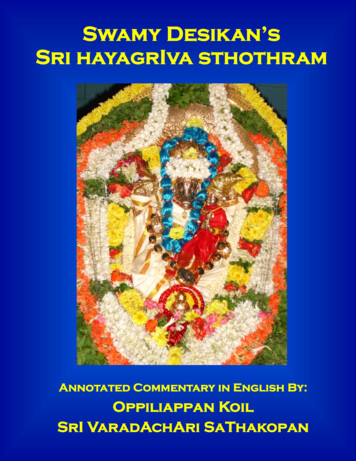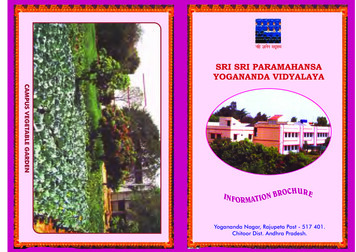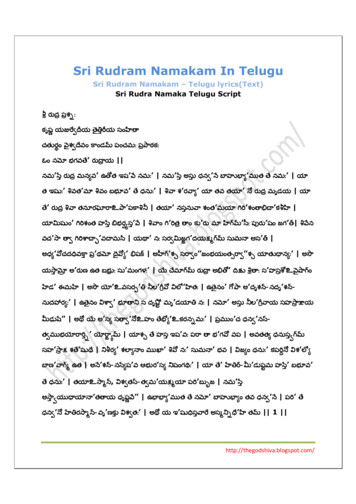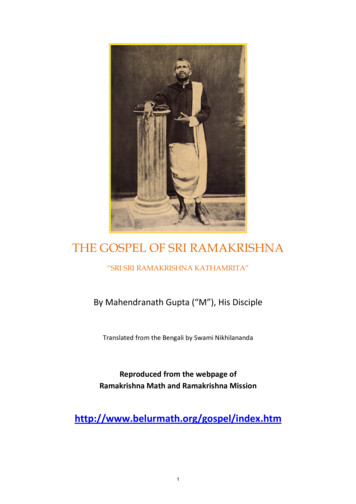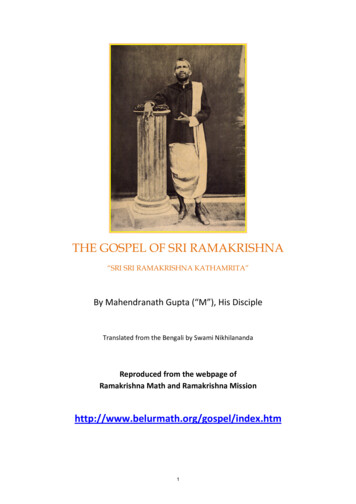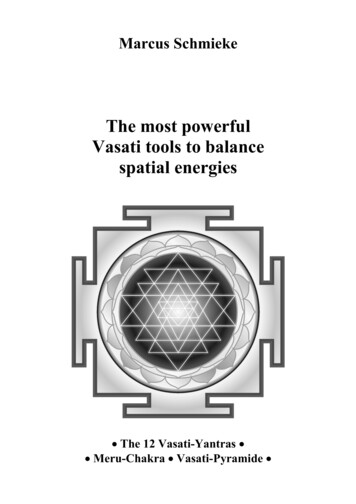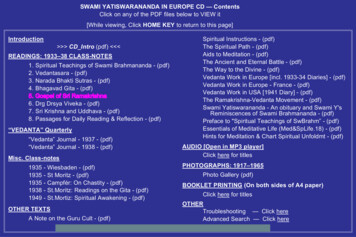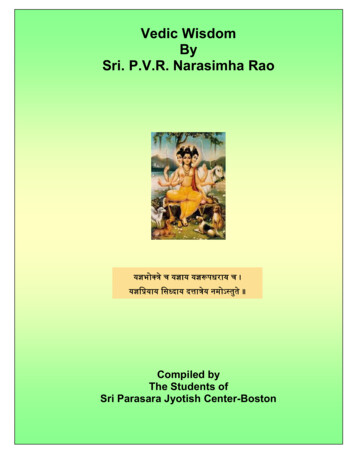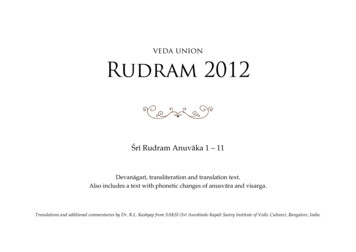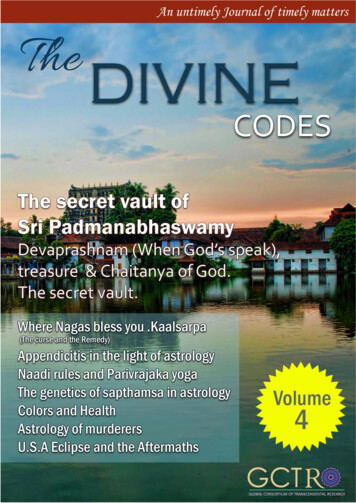
Transcription
Table of ContentsSri Namamrta: The Nectar of The Holy Name.1Preface.2Introduction.6The Holy Name: The Universal and Supreme Religion for this 20.11621.13222.141The Transcendental Attributes of the Holy 161i
Table of ContentsSri Namamrta: The Nectar of The Holy 89The Transcendental Effects of the Holy 6.34227.343ii
Table of ContentsSri Namamrta: The Nectar of The Holy Name28.348The Practice of the Holy 6.443The Propagation of the Holy Name.4481.4482.4553.4654.469Important Instructions.4711.4712.478iii
Table of ContentsSri Namamrta: The Nectar of The Holy 812.50013.50114.50215.50416.506Songs by Vaisnava Saints.515Sri Nama (from Gitavali).515Arunodaya kirtana Kirtana songs to be sung at dawn (from Gitavali).516Arunodaya kirtana part two.519Radha Krsna Bol (from Gitavali).520Kabe Ha'be Bolo (from Saranagati).521Sri Sri Gaura Nityanander Daya The Mercy of Sri Gaura and Nityananda(from Dhamali).523Ista deve Vijnapti Prayer to One's Beloved Lord (from Prarthana).526Important Verses.528*1.528II.533III.545IV.547V.549His Divine Grace A. C. Bhaktivedanta Swami Prabhupada.551iv
Sri Namamrta:The Nectar of The Holy NameSri Namamrta: The Nectar of The Holy Name1
PrefaceOn June 7, 1977, about four months before Srila Prabhupada left this world, I wrote him along letter. Although I had been his disciple already for a number of years, I had written tohim only once before, because I felt very timid about taking his time unnecessarily. At thispoint, however, I felt an urgent need to write to him, because I wanted to propose an ideathat had occurred to me while contemplating the possibility that he might leave us beforetoo long. As Srila Prabhupada's health was very poor at that time, I, like so many of myGodbrothers and Godsisters, felt compelled to deepen my understanding of my relationshipwith my spiritual master with reference to his anticipated absence. The obvious andcompelling question was, "In what form will my relationship with Srila Prabhupadacontinue after his physical departure?" Taking shelter of sastra, I found this statement inSrila Prabhupada's commentary to Srimad Bhagavatam 4.28.47: The disciple and spiritual master are never separated, because the spiritual master alwayskeeps company with the disciple as long as the disciple follows strictly the instructions ofthe spiritual master. This is called the association of vani (words). Physical presence iscalled vapuh. As long as the spiritual master is physically present, the disciple should servethe physical body of the spiritual master, and when the spiritual master is no longerphysically existing, the disciple should serve the instructions of the spiritual master.I could understand, therefore, that if I were to always very seriously attend to hisinstructions, I would always be able to feel enlivened by Srila Prabhupada's transcendentalpresence within my heart. This understanding was confirmed when I glanced at SrilaPrabhupada's expression of dedication to his spiritual master in the first volume of theBhagavatam, where he writes, "To Srila Prabhupada Bhaktisiddhanta Sarasvati GosvamiMaharaja, my spiritual master. He lives forever by his divine instructions and the followerlives with him."Now, where are those instructions? Those instructions are enshrined primarily within hisbooks. As Srila Prabhupada stated upon his return to Vrndavana from London, shortlySri Namamrta: The Nectar of The Holy Name2
before his physical departure, "There is nothing new to be said. Whatever I had to say Ihave already said in my books. Now you must all try to understand it and continue withyour endeavors." He also stated at around the same time, "If I depart, there is no cause forlamentation. I will always be with you through my books and my orders. I will alwaysremain with you in that way."It is clear from these instructions, then, that Srila Prabhupada lives on, in full transcendentalmanifestation in his divine instructions, and that we can contact him and receive his mercyby understanding and by executing those instructions. Anyone who makes even a humbleendeavor to research any particular philosophical point within Srila Prabhupada's bookswill discover a cornucopia of transcendental knowledge and insight. The thought occurredto me, however, that other than attending temple classes on Srimad Bhagavatam andBhagavad gita, few of us, for whatever reasons, undertake a systematic and comprehensivestudy of Srila Prabhupada's books, even if we have the opportunity to do so. I began,therefore, to reflect on how Srila Prabhupada's disciples and future followers might beprovided some system for drawing out instructions on specific subjects from his books in aneasy and convenient manner. With this concern in mind, I wrote Srila Prabhupada a letter inwhich I proposed that some sort of comprehensive, systematic compilation of all of hisinstructions from his books be executed. I offered to accept that difficult task, even though Ifelt personally unqualified to do so. Later that month,I received the following reply from Tamala Krsna Goswami, who was then acting as SrilaPrabhupada's secretary:My dear Subhananda Prabhu, Please accept my humble obeisances. I have been instructedby His Divine Grace Srila Prabhupada to reply your letter dated June 7th, 1977.His Divine Grace was very pleased to hear your proposal for systematically amassing asubject by subject encyclopedic compilation of all of Srila Prabhupada's teachings andinstructions as found in his books. Srila Prabhupada said that he knows that you are ascholarly devotee and are just fit for doing this job. He said, "It is a very welcomesuggestion."Sri Namamrta: The Nectar of The Holy Name3
Although most often preoccupied with other projects since receiving this order from myspiritual master, I have often meditated on how best to fulfill this instruction and have, atdifferent times, discussed the concept of this project with senior Vaisnavas. The basicconclusion of such meditations and discussions has been that the encyclopedia itself shouldnot be merely a quantitative compilation of all of Srila Prabhupada's words on every subject(which would be extremely voluminous), but that it should follow the traditionalencyclopedia format. Since the publication of Preaching Is the Essence and The SpiritualMaster and the Disciple, however, many devotees have urged me to produce comprehensivecompilations of Srila Prabhupada's instructions on at least the most important subjects ofKrsna consciousness, two of which have already been covered in these two publications.It therefore seemed natural that the next compilation (I hope to produce one every year orso) should be on the chanting of the maha mantra, because this is the foundation of thepractice of Krsna consciousness. I therefore now humbly offer this book, Sri Namamrta:The Nectar of the Holy Name, to all of Srila Prabhupada's disciples and granddisciples. Allof us should absorb our minds in these nectarean instructions with rapt attention andconscientiously apply their conclusions in our practical spiritual life. By studying SrilaPrabhupada's instructions on this most important of subjects, we will become fullyconvinced of the central importance of offenseless chanting of the holy name of Krsna inour endeavor for spiritual advancement.Sri Namamrta is divided into five principal parts: Part One reveals the chanting of the holyname, the Hare Krsna maha mantra, as the yuga dharma, the principal and universalreligion for this age of Kali. Part Two delineates the wonderful, transcendental attributesand effects of the holy name. Part Three offers a wide variety of practical instructions onthe practice of the chanting of the holy name, and Part Four deals with the necessity forpropagating the holy name throughout human society. Finally, Part Five presents a varietyof important instructions on the holy name not included in the other four sections.With few exceptions, I have not induded general references to sankirtana that do not makespecific reference to nama sankirtana, the chanting of the holy name. I have also decidednot to include in this book the numerous descriptive narrations of chanting of the holy namein caitanya lila (as found in Sri Caitanya caritamrta). Such descriptions can be foundeasily enough through the indexes to the various volumes of Sri Caitanya caritamrta. I havedecided, thus, to restrict this compilation to specific instructions about the holy name, asSri Namamrta: The Nectar of The Holy Name4
such.At the end of the book, one will find two helpful appendixes: The first is a collection ofsongs written by Srila Bhaktivinoda thakura, Srila Narottama dasa thakura, and Locanadasa thakura on the glories of the holy name. The second appendix lists over sixty of themost important verses from Vedic and Vaisnava literature glorifying the holy name.A few words of explanation concerning the system of compilation and organization used inthis book, as well as about some innovations, are in order here: (1) In going systematicallythrough Srila Prabhupada's books, whenever I come across a purport dealing with thesubject at hand, I have the relevant passage typed on an index card, and then I title it.Generally, I include only one central topic per index card entry. (2) If, within any purport,distinctly different points are made about the subject, separate index card entries are made,and each is appropriately titled and categorized. (3) In cases where two different but relatedpoints are presented in one interwoven discussion, or where one point applies equally totwo or more different topic categories, identical entries are prepared and placed withinappropriate categories. There is, in other words, a small degree of unavoidable duplicationof entries. (In some cases, such duplicate entries will be titled differently, appropriate totheir respective categories.) (4) Within any particular subsection, where two or more entriesare very similar in content, rather than duplicating exact or near exact entry titles, I haveallowed one entry title to suffice for the consecutive entries. (5) Rather than includingSanskrit or Bengali verse transliterations for every verse cited, transliterations are givenonly for the most important verses (those included in Appendix II). The transliterations forany other verses can be found in Srila Prabhupada's books. (6) When I have cited versesthat appear, in their original textual context, in conversational form, I have indicated whothe speaker and hearer are whenever possible. Further, as is often the case in SriCaitanya caritamrta, when a traditional scriptural verse is cited in conversation (as, forinstance, between Lord Caitanya and Rupa Gosvami), only the original speaker and hearerare given.In closing, let me say that it is my humble and fervent hope that by carefully studying,absorbing, and implementing the nectarean instructions found within this volume, many,many sincere souls will feel renewed inspiration to take the holy name of Sri Krsna as theirlife and soul. Subhananda dasaSri Namamrta: The Nectar of The Holy Name5
Introduction"I do not know how much nectar the two syllables 'Krs na' have produced. When the holyname of Krsna is chanted, it appears to dance within the mouth. We then desire many, manymouths. When that name enters the holes of the ears, we desire many millions of ears. Andwhen the holy name dances in the courtyard of the heart, it conquers the activities of themind, and therefore all the senses become inert."These lines, conceived in a state of religious ecstasy, flowed from the pen of Srila RupaGosvami, the great Vaisnava theologian and mystic, as he wrote his famous devotionaldrama Vidagdha madhava in early sixteenth century India. His equally famous brother,Srila Sanatana Gosvami, exults in his Brhad bhagavatamrta,All glories to the all blissful holy name of Sri Krsna, which causes the devotees to give upall conventional religious duties, meditation, and worship. When somehow or other utteredeven once by a living entity, the holy name awards him liberation. The holy name of Krsnais the highest nectar. It is my very life and my only treasure.To the uninitiated, these expressions of enthusiasm for the practice of contemplativerecitation of the name of God may appear odd. For how can repeated recitation of meresounds linguistic formulations transform consciousness and invoke ecstasy? Modernsecular students of religion, especially those of a reductionistic temperament, seek often todivest such spiritual experiences of their unique metaphysical properties, attributing them toquantifiable psychological (or other) causes. Some even view them as pathological. Butmere psychological reductionism can do little to shed light upon the profound religiousexperiences of those who "taste," in devotional ecstasy, "the nectar of the name." Nor can itexplain the profound influence this practice has had on the religious adepts of manySri Namamrta: The Nectar of The Holy Name6
different spiritual traditions, most prominently the Vaisnava religious tradition of India,within which the theology and practice of the holy name have reached their highestdevelopment.According to historically reliable literary accounts, medieval India witnessed a massivereligious renaissance centered largely on the popular mysticism of the congregationalchanting and singing of the names of God. This litany often took the form of themaha mantra: Hare Krsna, Hare Krsna, Krsna Krsna, Hare Hare/ Hare Rama, Hare Rama,Rama Rama, Hare Hare. The great sixteenth century saint Sri Caitanya, Himself worshipedas an incarnation of Lord Krsna, first turned this public congregational chanting(sankirtana) into a mass movement in Bengal and then spread it to other parts of northIndia, and later to the south of India, where, according to His biographers, He traveled onfoot for six years and converted millions to the religion of the holy name. The chanting ofthe divine name was no longer to be confined to the retreats of solitary mystics and hermits,but to spread itself widely and assume a central role in the spiritual
study of Srila Prabhupada's books, even if we have the opportunity to do so. I began, therefore, to reflect on how Srila Prabhupada's disciples and future followers might be provided some system
